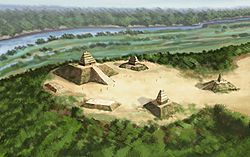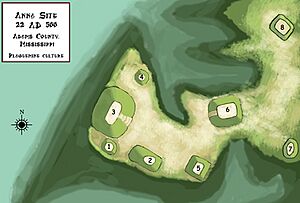Anna site facts for kids

Artists conception of the Anna site
|
|
| Location | Natchez, Mississippi, Adams County, Mississippi, |
|---|---|
| Region | Adams County, Mississippi |
| Coordinates | 31°41′43.37″N 91°20′59.17″W / 31.6953806°N 91.3497694°W |
| History | |
| Founded | 1200 |
| Abandoned | 1500 |
| Periods | Anna phase |
| Cultures | Plaquemine culture |
| Site notes | |
| Excavation dates | 1924, 1997 |
| Archaeologists | Warren K. Moorehead, James A. Ford, Jesse D. Jennings, John L. Cotter |
| Architecture | |
| Architectural styles | platform mound |
| Architectural details | Number of temples: 8 |
|
Anna site
|
|
| NRHP reference No. | 93001606 |
| Significant dates | |
| Added to NRHP | September 14, 1993 |
| Designated NHL | September 14, 1993 |
| Responsible body: Private | |
The Anna site (also known as 22 AD 500) is an ancient place where people used to live long ago. It's an archaeological site in Adams County, Mississippi, about 10 miles (16 km) north of Natchez, Mississippi. This site is very important because it helps us understand the Plaquemine culture, a group of Native Americans who lived in the Lower Mississippi Valley.
The Anna site is so important that it was named a National Historic Landmark in 1993. This means it's a special place that tells us a lot about American history.
Contents
What is the Anna Site?
The Anna site is located on a high piece of land, called a bluff, right above the Mississippi River. It's about 10 miles (16 km) north of Natchez, Mississippi.
This site has eight large earth mounds. Six of these mounds are built around a central open area, which archaeologists call a plaza. Imagine a big open space where people might have gathered.
The Mounds at Anna Site
The main group of six mounds is close to the bluff. The biggest mound, called Mound 3, is about 50 feet (15 meters) tall. It sits right on the edge of the bluff, looking over the river.
- A ramp goes down from Mound 3 to the plaza.
- Across the plaza, about 300 feet (91 meters) away, is a smaller mound called Mound 5. It's about 12 feet (3.7 meters) tall.
- Mound 4 is a small mound next to Mound 3. Digs here found signs of a building on top.
- Mound 1 is another small mound on the other side of Mound 3.
- Mound 2 is on the plaza, between Mound 1 and Mound 5.
- Mound 6 is placed diagonally near the plaza and also has parts of a ramp.
- Two other mounds, Mound 7 and Mound 8, are a bit further away from the main group.
Deep ditches, called ravines, surround the mounds. Pieces of Plaquemine culture pottery are found scattered around the area.
History of the Anna Site
People started building the Anna site around the year 1200. This was a time when different groups of people in the Lower and Middle Mississippian culture areas began to interact more. This interaction led to the development of the Plaquemine culture.
Early Occupations
Even before 1200, there were smaller groups of people living at the Anna site. The most important period of people living here began during the Gordon phase (1000–1200) of the Coles Creek culture period (700–1200).
- Mound building might have started during this early period.
- It definitely began by the next period, called the Anna phase (1200 to 1350).
- Building continued through the Foster phase (1350–1500) and the Emerald phase (1500 to 1680).
Over these 300 years, the Anna site grew into a very important center with many mounds in the region. It might have been ruled by powerful families. People lived at the site until about the year 1500. After that, there's no sign that anyone lived there again.
Archaeological Discoveries
Many archaeologists have studied the Anna site over the years.
- In 1924, Warren K. Moorehead and Calvin S. Brown dug at the site.
- Later, James A. Ford, Jesse D. Jennings, and John L. Cotter also worked there.
- Ford and Jennings suggested that the state of Mississippi should buy the site to protect it and build a museum there, but this didn't happen.
- John L. Cotter's work in 1951 was very important. His findings helped scientists understand the different time periods of the Natchez Bluffs region.
- In 1997, the Gulf Coast Survey and the Alabama Museum of Natural History did more digs. Their work confirmed what earlier archaeologists had found about the site's timeline.



